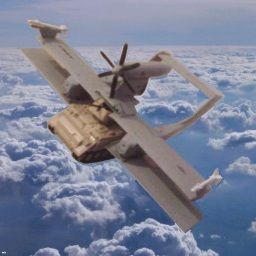Introducing the B-52X.

Ah, the Admiral pulled the old Galaxy-class out of mothballs to serve alongside the newest B52-class starship.
The Cosmofortress.
That’s the NCC-52.
Sir, we got the responses back for the RFP for a new strategic bomber.
Great captain, what did you get?
We got three proposals back. Two of them are direct copies of the B-52, but made by a different company.
Ok, and the third one.
Well sir, it’s from Boeing, so it’s just the B-52 but the bomb bay doors may fall off during flight.it’s just the B-52 but the bomb bay doors may fall off during flight.
Cunning. Extra munitions built into the airframe and deployable with minimal manual intervention. We’ll take 50.
Fun Fact a cold war project the “big stick” (Nuclear powered, Nuclear ICBM) had a “problem” that it’s exhaust was radioactive. Then the military said, no, that’s bonus damage, it will spread radiation even over enemy cities it doesn’t target, and we can fly it over more places to take advantage of that.
You can’t out-NCD Strategic Air Command
I heard you like to irradiate things, so I put a nuke in your nuke, so you can irradiate while you irradiate.
A project Pluto powered missile really would be the ultimate ‘screw you’, it could fly around enemy territory for days or more, spewing radioactive exhaust, launching warheads as it went, before finally hitting a target. Shoot it down and you have a nuclear mess, don’t and you have a wider nuclear mess.
You mean this?
The plane itself becomes a weapon in a pinch. Now that’s what I call efficiency.
The physics of a strategic atmospheric bomber hasn’t changed. The B52 is close to optimal in shape for the task. A lot can change, however, both within that shell, and construction materials it’s made of.
The physics of a strategic atmospheric bomber hasn’t changed. The B52 is close to optimal in shape for the task.
I mean, the B-1 and the B-21 are also strategic bombers, came out later, are still in the US inventory, and they look pretty different. I don’t know if I’d agree with an argument that the natural convergence is towards the B-52.


I think that a better argument is that the B-52 still effectively fills a desired role better than other options in 2025, but I don’t know if I’d say that that encompasses all strategic bombing.
EDIT: I guess I should really use the B-2 rather than the B-21 for the flying wing example. The B-21 is flying, but not yet in USAF service. I was just kinda happy that I could find flying B-21 photographs.
The B1 is by far a superior plane, on a level of wikipedia-page comparisons. Faster, newer, more space, better electronics, etc etc.
The problem is, the B-52 was originally built to last basically forever. It was made to go there, drop ALL the bombs, go home and do it again and again until you’re out of bombs or targets. It’s a literal flying brick and they will never break. The B-1 was… well, lets just say it’s intended mission was highly likely one-way, either because of the enemy blowing up the plane or the country of origin.
That different strategy means the B-52 is still very popular, because you can keep it running by a one-armed chimp with a bucket of grease and a hammer. It’s easy and basically free (as far as military planes go). The B-1 very much isn’t either, and the B-2 REALLY isn’t.
And the B-2 costs a BILLION dollars. With a B. You can literally buy a dozen B-1’s for the cost of a B-2, and have money left over to buy a really nice runway too. Nobody is going to use those for anything but the most special missions. If they still made B-52H’s, you could get an entire wing of them (120 planes) for the cost of a single B-2, and you’d have spare money for a nice set of airstrips, a control tower and a small town to support it.
So, the B-52 does it what it has to do, cheaply, easily, consistently and very well. That’s why it’s still around. I’m convinced the B-1 is only still around because building more B-52’s isn’t profitable to the MIC.
I’m convinced the B-1 is only still around because building more B-52’s isn’t profitable to the MIC.
I went digging and what I found surprised me.
2010 numbers.
B-1 $63k / flight hour
B-52 $72k
B-2 $135k
JDAMs, dumb bombs made smart, are primarily the B-1 role. Higher tech munitions are primarily the B-52 role.
I think that when they want it done cheap they use the B-1.
Huh, that’s very surprising seeing what I read about maintenance and downtime of the B1.
I’m not an expert but know enough to converse. As I understand it:
The B-1 should be more expensive to fly than the B-52 because of its variable wing geometry and the nature of its engine. But, we spent a boatload of cash to make the B-1 cheaper. We put soft constraints on the performance envelope in mission design then optimized the aircraft for it.
We didn’t update the B-52 because it was far more expensive: replace 8 engines designed in the 1950s with 2 or 4 modern engines, requiring redesign of wing, tail, and cockpit, as well as manufacturing of old parts due to scarcity. If we’d spent for engine modernization then it’d be cheaper to fly because that style of airfrane is almost always cheaper to fly than an airframe that can comfortably sustain Mach 1. It’d even be cheaper to fly for the B-1 mission because we don’t ask the B-1 to leverage the Mach 1 speed it was designed for.
It’s shit like this that helps my civilian self understand the meaning of FUBAR. A rare example of a well-run program is the C-130.
The B-2 probably serves more as a deterrent. It tells would be enemy states that if we wanted to, we could bomb them anywhere. They can’t defend against it.
An enemy might think that they have a chance at defending themselves from B-52s, or at the very least, prepare. With a B-2, they could be anywhere at anytime, and no one would even know.
Wasn’t the quote for the b2 much more reasonable, but after Congress ordered the air force to reduce the number (in the hope of reducing the budget), the count reduced, but the price remained the same, making each aircraft more expensive?
I already didn’t include all the setup and R&D, “Just” the building cost and spares, etc etc. If you want to include the entire program, that’s more like 2.1 billion dollar per unit, but that seemed really unfair.
Of course, marginal costs also go down when scaling up, but not hugely.
Poor wording on my part.
The B1 trades rugidisation and capacity for speed.
The B21 trades them for stealth.
B52 is optimal for mass bombing. It’s shape makes spares, repairs and production cheap. It’s optimised for bombs/$ via mass deployment. The B1 and B21 could fill the role, but not as well. They are optimised for other uses (B1, get in fast, smash a target and get out. B21, sneak in and pummel a limited target.)
That being said, the last time the US needed that capability was likely Vietnam eta (leveling large areas of jungle). Having it available is still militarily useful.
The B-52 is “A big bomber.”
The B-1 is “A supersonic bomber.”
The B-2 is “A stealth bomber.”
Which is also why we’re up to the B-52J which is the 10th iteration and has upgrades in 2020.
B-52 are crabs confirmed
We’ll just roll out the modern planes like the A-10 and the F-16…Over 40 what? To shreds you say?

The Orcas are learning
I can’t see that top image without thinking of HLC / Grandpa Buff…
I have that game. The mission from the book was rather hard for teenage me, though I had read the book and knew what to do








